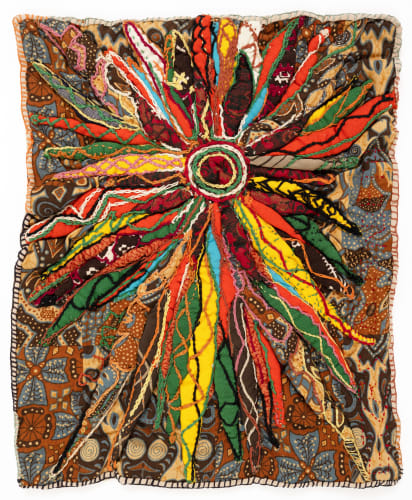Elizabeth Talford Scott’s Quilts Defy the Grid
“Quilt” is an insufficient description for the extraordinary fabric pieces Scott began to construct in the 1970s.
By Judith Stein
BALTIMORE — Both Sides Now, the resonant title of Elizabeth Talford Scott’s exhibition at Goya Contemporary, hints at the artist’s uncanny ability to see not only what her materials are but also what they might become. Born on Blackstock Plantation near Chester, South Carolina, Scott (1916–2011) grew up as the child of sharecroppers who worked the same land toiled by her enslaved grandparents. Of necessity, her forebears were past masters at “making something out of nothing,” creating what was needed from what was freely available. It was a legacy that would enrich the creative lives of their descendants for generations.
During the Great Migration, Scott left the rural South and moved to Baltimore, where she worked variously as a domestic, cook, and caregiver. After her daughter left for college, she returned to quilting, a skill she learned as a child. But “quilt” is an insufficient description for the extraordinary fabric pieces she began to construct in the 1970s. Many are in low relief, with puffy compartments or whimsical pockets of pebbles or shells, held in place by repurposed netting she snitched from onion sacks. In others, tangible chorus lines of cloth knots or faux pearls toe the irregular line of Scott’s hand-stitched edges. The airy fringes of wool she favored provided pathways for spirits to come and go, she once told Amy Eva Raehse, Goya Contemporary’s director.
Prior to cataract surgery, Scott perceived the world through a mediating scrim that modified her vision. The two earliest of the show’s 13 works, “Infected Eye” (1979–80) and “Sick Eye” (1980), are autobiographical. Each composition focuses on an embroidered circle with radiant appendages that evoke the pupil and iris. Despite areas of colorful fabric and thread, the background palette of amber, beige, and black establishes a prevailing somber tone.
“Abstract 1” (1983) is kin to both historical quilts and the expressive freedom of paintings by Arshile Gorky or Conrad Marca-Relli, art it’s unlikely she knew. Scott chose a variety of embroidery stitches and colored threads to embellish boundaries between her patches, a nod to the tradition of crazy quilts. But the work’s impish composition is distinctively her own. Rambunctious shapes at its center partially escape the constraints of a helter skelter grid. The only “true grid” in the work is found on printed or woven scraps with readymade crosshatching.
In “Birthday” (1997), the compartments shaped by Scott’s gloriously disheveled grid resemble farmland seen from above, each with a story to tell, if only we knew how to read it. Several pieces include playful critters and imaginative gardens, water and sky that bespeak the artist’s rural upbringing. For friends, she constructed healing shawls or prayer shields that reflect her spiritual life.
Whether fostered by nature, nurture, or both, Elizabeth Scott’s daughter, Joyce J. Scott, developed a singular artistic practice that would be honored with a MacArthur Award. When living in the same household, the two women enjoyed a unique synergy, at times sharing materials or working side by side on separate projects. In Joyce’s words, “My mother was my muse.”
Both Sides Now: The Spirituality, Resilience, and Innovation of Elizabeth Talford Scott continues at Goya Contemporary (Mill Centre Studio 214, 3000 Chestnut Avenue, Baltimore, Maryland) through April 21. The exhibition was curated by Amy Eva Raehse.


